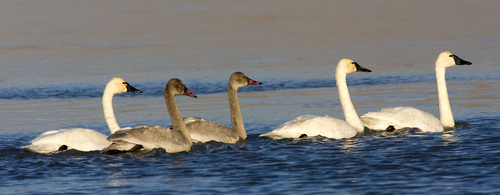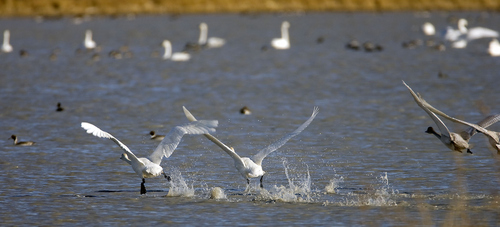This is an archived article that was published on sltrib.com in 2014, and information in the article may be outdated. It is provided only for personal research purposes and may not be reprinted.
There wasn't a cloud in the sky and nary a drop of moisture showing up on the radar Monday evening when meteorologists at the National Weather Service in Salt Lake City noticed a large, and growing, blip due west of Salt Lake City.
It was about 5:30 p.m. and Randy Graham quickly developed an answer.
"Must be the swans," said Graham, science operations officer with the service in Salt Lake City.
Swans, as in a huge number of tundra swans departing the marshes of the Great Salt Lake for warmer temperatures to the south.
The echo on the radar continued to grow, and by 7 p.m. it had stretched from the southwest end of the Great Salt Lake along the west side of the Oquirrh Mountains all the way to the Tooele/Juab county line — more than 50 miles.
"We see at least one of these events every December," Graham said. "It happens in early December and always right after sunset."
Tundra swans — which weigh roughly 25 pounds and have a wing span up to 5½ feet — make their way through Utah twice a year during their 3,500-mile trek from the Arctic tundra to central California and back.
Christine Kruse, a meteorologist with the National Weather Service, said the flock appeared to be moving at around 40 mph as it crossed Tooele County.
Utah Division of Wildlife (DWR) officials say an average high count of tundra swans in the state is about 40,000 birds, with as many as 60,000 reported on big years.
Blair Stringham, waterfowl coordinator with the DWR, said the radar could have been picking up tundra swans. If so, it was likely the last of the migrants.
A swan count in early November on the Great Salt Lake marshes showed more than 22,000 of the big birds. By mid-November, an estimated 35,000 tundra swans were there. However, the birds have been heading south in large groups with the recent cold weather.
By Nov. 26, the swan count was down to 13,000, and by Dec. 4 there were only about 4,000 left on the marshes.
Stringham said it is also possible that the blip was caused by eared grebes, or by a combination of all the waterfowl which use the Great Salt Lake and its surrounding marshes as a staging area while migrating.
"There have been some big groups of grebes and coots on the lake," he said. "There also could have been a large number of new birds that moved into the area. This could easily have been a combination of birds."
Eared grebes — a much smaller bird with a reputation for massive migration groups — have made the news in Utah in recent years for other reasons.
In April, several hundred eared grebes died and an estimated 5,000 became stranded on the ground when they apparently mistook wet pavement for a lake at the U.S. Army's Dugway Proving Ground in Tooele County. Grebes cannot take off for flight from land, only from water.
About 1,500 grebes died in December 2011 and another 3,500 were rescued during a similar incident in a Wal-Mart parking lot in Cedar City.
Twitter: @BrettPrettyman —
Watch the wave
Images from the National Weather Service show the line of swans moving south. See them on the service's Facebook page.















